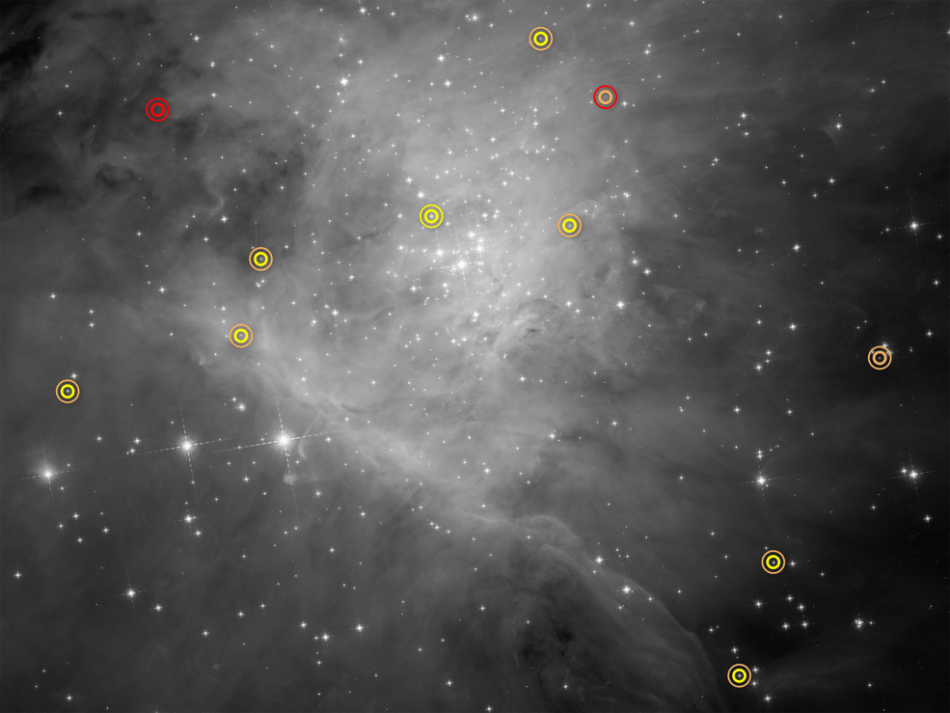Jan 12 2018
In an exceptional deep survey for small, faint objects in the Orion Nebula, astronomers using NASA’s Hubble Space Telescope have discovered the largest known population of brown dwarfs scattered among newborn stars.
Observing the vicinity of the survey stars, the researchers not only discovered numerous very-low-mass brown dwarf companions, but also three giant planets. They even discovered an instance of binary planets where two planets orbit each other in the absence of a parent star.
 This image is part of a Hubble Space Telescope survey for low-mass stars, brown dwarfs, and planets in the Orion Nebula. Each symbol identifies a pair of objects, which can be seen in the symbol’s center as a single dot of light. The thicker inner circle represents the primary body and the thinner outer circle indicates the companion. The circles are color-coded: red for a planet; orange for a brown dwarf; and yellow for a star. Located in the upper left corner is a planet-planet pair in the absence of a parent star. In the middle of the right side is a pair of brown dwarfs. The portion of the Orion Nebula measures roughly four by three light-years. (Image credits: NASA , ESA, and G. Strampelli (STScI))
This image is part of a Hubble Space Telescope survey for low-mass stars, brown dwarfs, and planets in the Orion Nebula. Each symbol identifies a pair of objects, which can be seen in the symbol’s center as a single dot of light. The thicker inner circle represents the primary body and the thinner outer circle indicates the companion. The circles are color-coded: red for a planet; orange for a brown dwarf; and yellow for a star. Located in the upper left corner is a planet-planet pair in the absence of a parent star. In the middle of the right side is a pair of brown dwarfs. The portion of the Orion Nebula measures roughly four by three light-years. (Image credits: NASA , ESA, and G. Strampelli (STScI))
Brown dwarfs are a peculiar class of celestial object that possess such low masses that their cores never get hot enough to sustain nuclear fusion, which powers stars. Instead, brown dwarfs cool and fade with time. In spite of their low mass, brown dwarfs offer crucial clues to understanding how planets and stars form and may be among the most common objects in Earth’s Milky Way galaxy.
Situated 1,350 light-years away, the Orion Nebula is a comparatively nearby laboratory for exploring the star formation process across a wide range, from opulent massive stars to diminutive red dwarf stars and obscure, faint brown dwarfs.
This survey could only be performed using Hubble’s extraordinary resolution and infrared sensitivity.
Since brown dwarfs are colder than stars, astronomers used Hubble to spot them by the presence of water in their atmospheres. “These are so cold that water vapor forms,” explained team lead Massimo Robberto of the Space Telescope Institute in Baltimore, Maryland. “Water is a signature of substellar objects. It’s an amazing and very clear mark. As the masses get smaller, the stars become redder and fainter, and you need to view them in the infrared. And in infrared light, the most prominent feature is water.”
But hot water vapor in the atmosphere of brown dwarfs cannot be easily observed from Earth's surface, because of the absorbing effects of water vapor in Earth’s own atmosphere. Luckily, the Hubble telescope is up above the atmosphere and has near-infrared vision that can easily detect water on distant worlds.
The Hubble team spotted 1,200 candidate reddish stars. They discovered that the stars split into two diverse populations: those containing water, and those without. The bright ones with water were established to be faint red dwarfs. The horde of fainter water-rich, free-floating brown dwarfs and planets within the Orion nebula are all recent discoveries. Many stars not containing water were also identified, and these are background stars in the Milky Way. Their light was reddened by passing via interstellar dust, and thus not applicable to the team’s study.
The team also searched for fainter, binary companions to these 1,200 reddish stars. Since they are so close to their principal stars, these companions are almost impossible to find using standard observing techniques. But by using a unique, high-contrast imaging method developed by Laurent Pueyo at the Space Telescope Science Institute, astronomers were able to resolve faint images of numerous candidate companions.
This first analysis did not allow Hubble astronomers to establish whether these objects orbit the brighter star or if their proximity in the Hubble image is a consequence of chance alignment. As a result, they are classified as candidates for the time being. However, the presence of water in their atmospheres specifies that majority of them cannot be misaligned stars in the galactic background, and therefore must be brown dwarfs or exoplanet companions.
In total, the team discovered 17 candidate brown dwarf companions to red dwarf stars, one brown dwarf pair, and one brown dwarf with a planetary companion. The survey also identified three probable planetary mass companions: one related to a red dwarf, one to another planet and one to a brown dwarf.
Uniting two unique methods, imaging in the water filters and high-contrast image processing, the survey provided an impartial sample of newly developed low-mass sources, both dispersed in the field and companions of other low-mass objects. “We could reprocess the entire Hubble archive and try to find jewels there,” Robberto said.
Locating the signatures of low-mass stars and their companions will become a lot more efficient with the unveiling of NASA's infrared-sensitive James Webb Space Telescope in 2019.
The Hubble Space Telescope is a project of international cooperation between NASA and ESA (European Space Agency). NASA’s Goddard Space Flight Center in Greenbelt, Maryland, manages the telescope. The Space Telescope Science Institute (STScI) in Baltimore, Maryland, conducts Hubble science operations. STScI is operated for NASA by the Association of Universities for Research in Astronomy, Inc., in Washington, D.C.